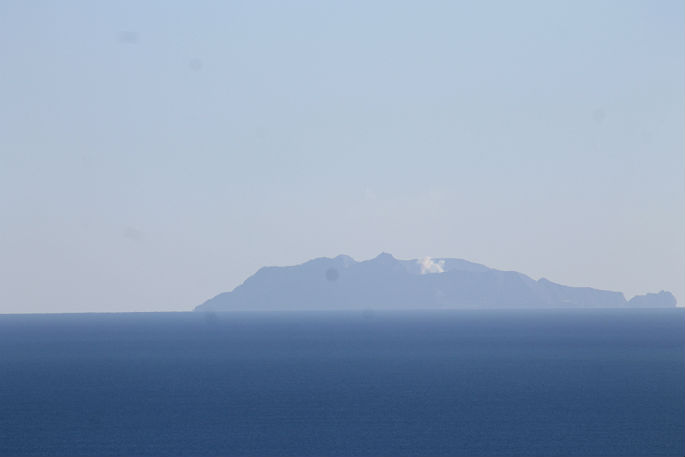An international team of scientists with several New Zealand participants will drill into a hydrothermally active submarine volcano northeast of White Island.
The idea behind the drilling is to learn more about how metals move through the Earth's crust and find out about the life forms that live in these extreme environments.
The two-month-long expedition, setting out from Auckland on Wednesday, will drill three boreholes into Brothers submarine volcano in the Kermadec arc, 400km northeast of White Island.
It will be the first project of its type anywhere in the world.
Brothers is three times the size of White Island and its summit rises to within 1200m of sea level. It is arguably the world's most hydrothermally active volcano, and partly because of this it is an attraction to scientists from around the world.
The US$15 million project will use the deep-sea research ship JOIDES Resolution which is operated by the International Ocean Discovery Program (IODP). The expedition is funded by the consortium of 23 countries that make up IODP, with the single largest contributor being the National Science Foundation in the United States.
'In the year that marks the fiftieth anniversary of IODP and its predecessor organisations, we are particularly delighted to set out on this unprecedented fascinating endeavour of drilling an active submarine volcano in New Zealand waters,” says Dr Tobias Höfig, the IODP Expedition 376 Project Manager from Texas A&M University, which manages JOIDES Resolution operations.
The voyage will be jointly led by scientists from GNS Science and Woods Hole Oceanographic Institution in the United States. New Zealand's participation in IODP is coordinated by GNS Science in partnership with other Australian and New Zealand research organisations and universities that make up the Australian and New Zealand IODP Consortium (ANZIC).
The mission's most ambitious borehole aims to reach a depth of about 800m into a cone growing up inside the caldera of the volcano and the other two will reach depths between 400m and 570m at the top and base of the caldera walls, respectively. The drilling will likely encounter rock material as hot as 400oC.
Expedition co-chief scientist Cornel de Ronde of GNS Science, who has visited Brothers volcano 12 times before using surface ships and remotely operated vehicles, says all magmas contain small amounts of metals, but the magma and resultant volcanic rock at Brothers is unusually rich in metals such as copper, gold, silver and molybdenum.
'We don't really know the full range of metals and in what quantities we will find at Brothers, or even how they are distributed within the volcano. But if the chimneys sitting on the seafloor are anything to go by, we suspect we will see networks of veins beneath the seafloor that will be host to significant copper, zinc and gold mineralisation,” says Cornel.
'This voyage will increase our understanding of where these metals come from and how they accumulate in submarine volcanoes, which may help in the extraction of these economically important and critical metals in similar settings worldwide.”
Voyage co-chief scientist Susan Humphris, of US-based Woods hole Oceanographic Institution, says while the main goal the expedition is to shed light on how metals are transported from the Earth's mantle to the ocean floor, it will also help scientists better understand what regulates the chemical composition of seawater.
'Chemical reactions between rocks and seawater at depth in the volcano change the chemistry of the fluid that is released through hydrothermal vents into the ocean,” says Susan.
In addition to the earth science aspect of the voyage, the scientists will also study the unusually rich biological life at Brothers. The hundreds of vents and chimneys, some as tall as 20m, that discharge fluids with temperatures up to 310 degrees Celsius are focal points for a wide range of marine life from microbes to tubeworms.
'We expect to discover microbes in this extreme environment that are completely new to science,” says Cornel.
As well as tolerating temperatures as high as 120 degrees Celsius, some of the micro-organisms are happy to live in fluids that are as corrosive as battery acid.
Learning more about the thermal and chemical tolerance of microbes thriving around the hydrothermal vents at Brothers is likely to help evolutionary biologists better understand how life started on early Earth.
IODP is an international research collaboration that conducts seagoing expeditions to study Earth's history and dynamics recorded in sediments and rocks beneath the ocean floor. New Zealand participates in IODP through a consortium of research organisations and universities in Australia and New Zealand, including GNS Science, NIWA, The University of Auckland, Victoria University of Wellington, and University of Otago.
The Australian and New Zealand IODP Consortium, which supports participation of New Zealand scientists and outreach officers on these voyages, is funded by the Australian Government through the Australian Research Council's LIEF funding scheme and an Australian and New Zealand consortium of universities and government agencies.



0 comments
Leave a Comment
You must be logged in to make a comment.